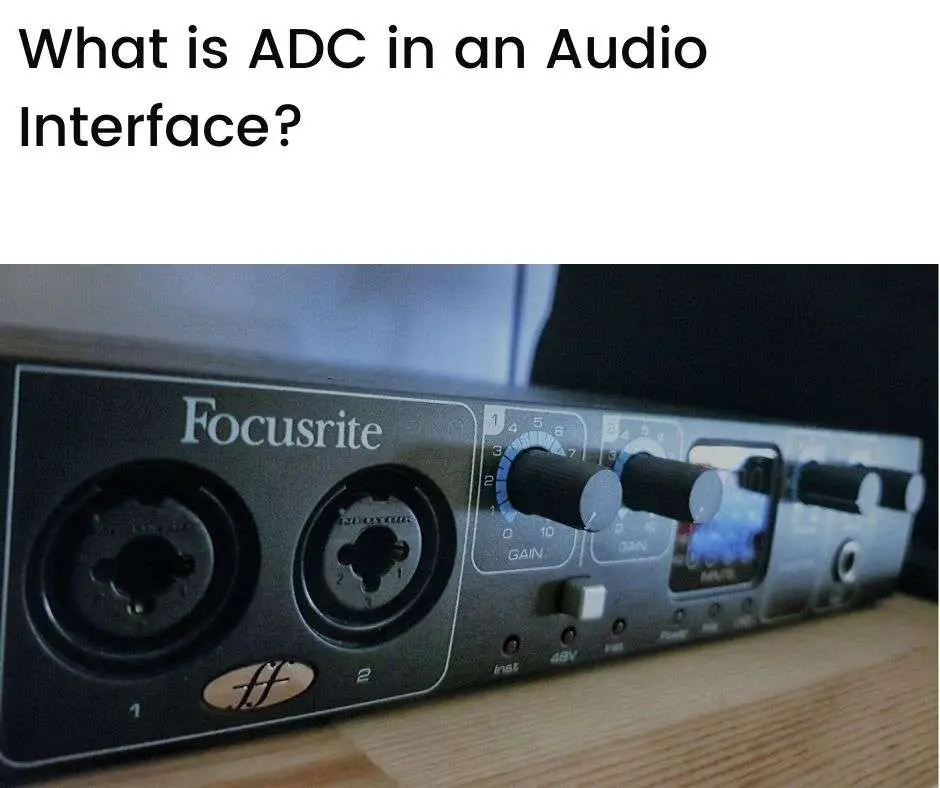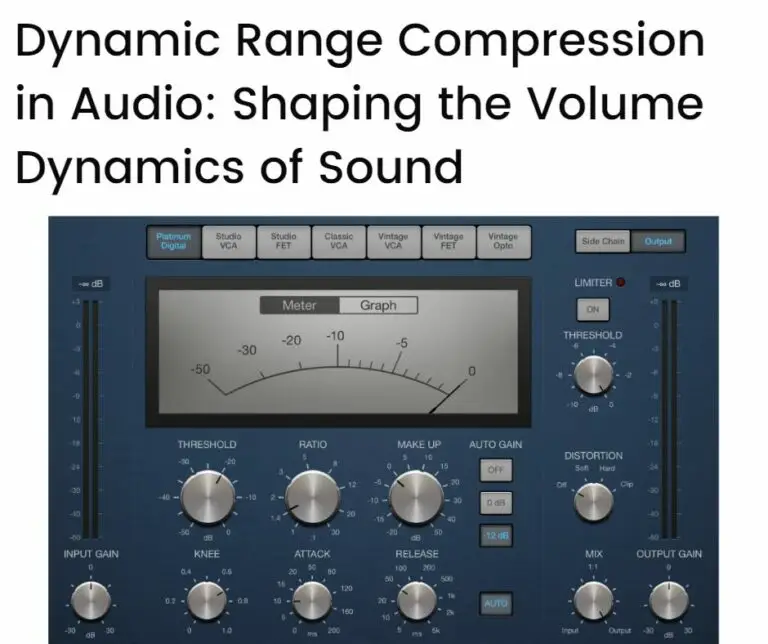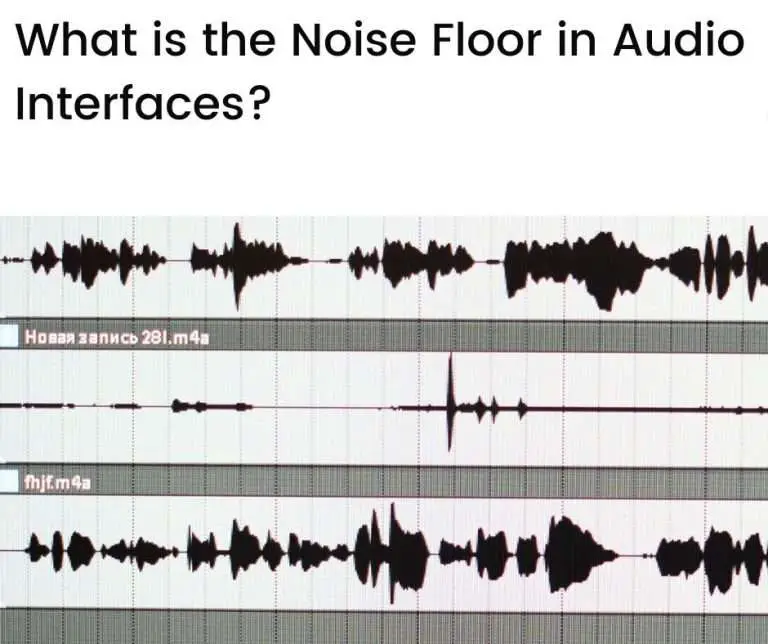One of the main functions of an audio interface is to convert sound from physical instruments or microphones (analog) to a form that computers can process (digital). This is called analog-to-digital conversion, or ADC. It is a necessary part of the digital audio workflow.
In this article we’ll look at:
- What is ADC?
- Real-world sounds are continuous and analog
- The digital audio workflow
- DAWs and DAC
- The role of audio interfaces
- Conclusion
What is ADC?
ADC, or analog-to-digital conversion, is the process of converting sound from an analog to a digital form. It’s a fundamental part of what audio interfaces do (along with digital-to-analog conversion, or DAC, which is the reverse process of converting digital audio data back into analog sound).
Real-world sounds are continuous and analog
Think of the sound produced by a (physical) instrument or a voice.
Whether directly or through an amplified speaker system, the sound travels through air from the instrument or voice to our ears.
The same principle applies if you are wearing headphones, by the way — it’s just that the distance to travel is very small (ie. the small gap between the headphones’ speakers and your eardrums).
Sound travels through a medium, such as air, by causing vibrations in the particles of the medium.
Sound can travel in this way through water, solid materials, or other gases besides air, but there needs to be some physical substance present to transmit sound (even air has physical properties). This is why, for instance, sound can’t travel in a vacuum.
When we listen to sound, our ears respond to the movements in air caused by the traveling sound waves.
Our ears then process these sound waves through a complex series of interactions between our outer ear (which collects the sound waves), our middle ear (where tiny bones respond to and amplify the sound waves), and our inner ear (where the cochlea transforms the sound waves to electrical signals).
From there, our nervous system takes over (via the auditory nerve) to transmit the electrical signals generated by our ears to our brains for processing.
This whole process occurs in a continuous, real-world environment in which every small vibration is registered for what it is (to a precision level that our ears and brains allow).
The human experience as we know it is an analog experience—our interpretation of sound is through continuous electrical signals (produced by our ears and sent to our brains) rather than through a series of numbers or discrete packets of information.
The digital audio workflow
Modern computers, on the other hand, operate in a discrete, binary world. They process information as a series of digits represented in a binary form (ie. as 0s and 1s).
The history of why computers have evolved in this way is a long one, with a combination of factors that have led to it.
Incidentally, such a thing as “analog computing” exists, with early examples from the 1870s. But there are many reasons why digital computing has dominated, including advancements in digital electronic component manufacture.
Given the sheer power and capabilities of today’s computer technology, it’s easier and more effective to process information (including audio) in a digital form using computers.
Hence, in a digital audio workflow where computers are the main processing engine, the analog signals from instruments or voice (through microphones) need to be converted into a digital form.
This is where analog-to-digital conversion, or ADC, comes in.
DAWs and DAC
Once audio signals have been converted to a digital form using ADC, they can be processed using specialized audio software packages (often referred to as digital audio workstations or DAWs).
Modern DAWs are extremely powerful and allow a range of mixing, processing, and production possibilities for digitized sound.
After the digitized sound has been processed, it can then be transferred to an output format directly in a digital form, such as to a CD.
But in order to monitor the audio production process, the digitized sound needs to be converted back into a form that human ears can hear—this is done using digital-to-analog conversion, or DAC, which is the reverse process of ADC.
And to help with the important tasks of converting audio from digital to analog and back again, at the heart of most modern digital audio workflows are audio interfaces doing ADC and DAC processing.
The role of audio interfaces
ADC is a specialized task that requires specific hardware and software solutions.
As it happens, most computers include an in-built sound card that can do ADC and DAC.
(The “sound card” may simply be a “sound chip” built into the computer’s motherboard—we’ll refer to both possibilities as a sound card.)
While these sound cards are adequate for everyday use, they do not produce a quality of output that’s sufficient for many audio processing requirements.
This is why audio interfaces play an important role.
Audio interfaces are specialized hardware and software devices that are dedicated to ADC, DAC, and other functions.
Being specialized, audio interfaces generally produce much better output than computer sound cards and are included in any digital audio workflow where sound quality is important.
Other than being specialized for ADC and DAC processing, however, audio interfaces offer a range of other benefits, such as:
- They can have multiple inputs through various connection types (eg. XLR, TRS, and RCA connections)
- They can have a choice of outputs for better sound monitoring during the production process
- They can help to reduce latency in the audio production workflow
- They often include high quality pre-amps for microphone or low-level signal boosting
- They generally produce an overall higher quality of sound relative to computer sound cards
Despite their benefits, audio interfaces (or ADC in general) may not be necessary if a production process does not include any physical instruments or voice (eg. when using only virtual instruments).
In such cases, there’s no need to convert sound from an analog to a digital form, and there’s no need for ADC.
Sound would need to still be converted from digital form to analog for monitoring purposes, however—so that human ears can hear the results of the production process—but a computer’s in-built sound card may be sufficient in this case.
Conclusion
ADC is the process of converting analog (real-world) sound to a digital form for computer processing.
ADC is a complex task that requires specialized hardware and software.
Audio interfaces are dedicated ADC processing devices. They offer a range of other benefits as well, including digital-to-analog conversion (DAC), low latency, and choices of inputs and outputs.
Audio interfaces, being specialized devices, generally produce a higher quality of sound than comparable general-purpose devices (such as a computer’s in-built sound card).
And while audio interfaces may not be necessary for audio production tasks that use only virtual instruments or sounds, they are used extensively in digital audio workflows where physical instruments and voice are used, and where sound quality is an important factor.







